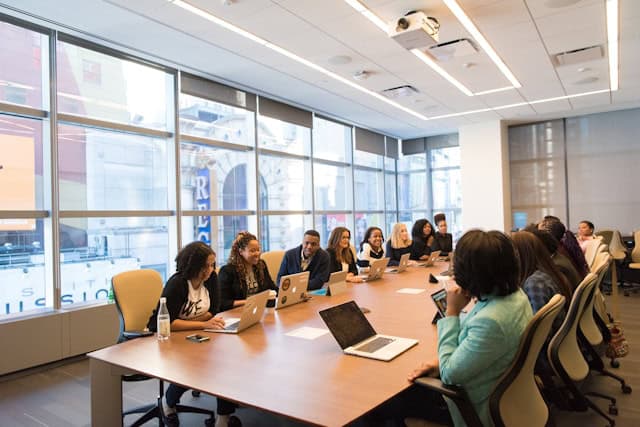The Future of Workspaces: Adapting Office Layouts for Hybrid and Remote Work Models
In recent years, the workspace has undergone significant changes. With the rise of hybrid and remote work models, adapting office layouts has become crucial. This shift is not just a trend but a response to evolving work dynamics that demand flexibility and innovation. As you think about business development and marketing consulting, consider how a redesigned space can impact productivity and creativity.
The Shift to Hybrid Models
Hybrid work models, which combine in-person and remote working, are quickly becoming the norm. 41% of U.S. workers who can work remotely have a hybrid arrangement. This model offers flexibility, helping you maintain work-life balance while providing opportunities to collaborate face-to-face when needed. For businesses, this flexibility can lead to lower overhead costs and access to a broader talent pool.
Challenges of Remote Work
While remote work offers significant advantages, it comes with its own set of challenges. Many workers report feelings of isolation and difficulties in communication. Effective office design can play an important role in mitigating these issues.
Principles of Adapting Office Layouts
When it comes to adapting office layouts, the focus is on creating spaces that are as flexible as they are functional. Consider the role of future trends in commercial construction in shaping office environments that are adaptable and equipped for the future. By integrating technology and flexible design elements, such as movable walls and multipurpose areas, you can create a workspace that adjusts to daily needs and fosters a sense of community.
Balancing Spaces
Create designated areas in your workspace that cater to both collaborative and individual work. This approach acknowledges that employees perform best in environments suited to their tasks and personal preferences. Also, as your company grows or changes its strategies, consider the role of adaptable spaces in minimizing the stress and costs associated with commercial relocation. These flexible environments are not just about the physical layout changes; they’re about rethinking how these spaces can better serve the daily needs of your employees, ensuring productivity and connectivity in your workforce.
Technology Integration
For seamless hybrid and remote working, good internet connectivity and a modern IT infrastructure are essential. These support crucial functions like video calls and cloud-based operations. Additionally, equip your team with tools that boost remote collaboration, such as digital whiteboards and team collaboration software, to keep everyone connected and productive.
Flexible Design
Integrate movable furniture and adjustable settings in your office to accommodate different activities and team sizes effectively. Alongside this, investing in soundproofing materials and strategic designs will help minimize distractions. This ensures employees can focus better, regardless of whether they are working remotely or from the office.
Make Your Office Adaptation Easier With Professional Help
When transitioning to a new office or adapting your office layout, partnering with a reliable moving company can significantly ease the process. Established in 2013, Good Neighbors Moving Company specializes in commercial relocations across Los Angeles County, ensuring your move is seamless and efficient. With their expert knowledge and comprehensive services, this company provides peace of mind, making them a trusted partner in commercial moving.
Case Studies on Adapting Office Layouts
Leading companies have adapted their workspaces for hybrid and remote models. Microsoft redesigned its Redmond headquarters with flexible meeting rooms and communal spaces. Salesforce created “Trailblazer Ranch,” a collaborative, nature-inspired retreat center. These changes improved productivity and employee engagement, supporting corporate mobility to accommodate workforce shifts and market changes.
Innovative Design Solutions
Innovative office designs are crucial for fostering a productive environment. Consider how remote management tools and spaces can enhance team coordination and project tracking across different locations. Examples of innovative solutions include:
- Smart Lighting Systems: Adjusting the lighting based on the time of day or the number of people in the room, thereby saving energy and enhancing work comfort.
- Acoustic Panels: These can be rearranged to create quieter zones for focused work or opened up for team discussions.
Sustainability in Design
When adapting office layouts, sustainability is increasingly at the forefront:
- Green Materials: Using sustainable materials like bamboo flooring and recycled furniture.
- Energy Efficiency: Installing sensors to manage heating, cooling, and lighting more efficiently.
Future Trends in Office Design
Looking ahead, the future of office design seems geared towards even more personalized and technologically integrated solutions. Here are some anticipated trends:
- Biophilic Design: Incorporating natural elements into office spaces to increase employee connection to nature.
- AI and Automation: Using AI to manage room bookings or control environmental settings based on occupancy.
These Office Layouts are The Future
As you think about the next steps for your workspace, remember that adapting office layouts is about more than just aesthetics. It’s about creating environments that respond to the needs of your team, encouraging productivity, and fostering a sense of community.











